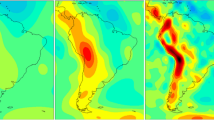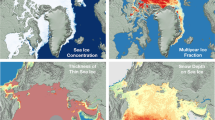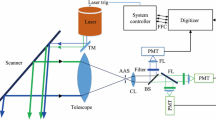Abstract
Results of experimental determination of the laser radiation extinction index by the gradient method from the depth profiles of the airborne polarization lidar return signal power for clear and coastal sea water in the subsurface layer are presented. Based on synchronous measurements of the polarized and depolarized signal components with the “Makrel” lidar operating at a wavelength of 532 nm, laser radiation extinction coefficients were estimated. It has been experimentally demonstrated that the polarized and depolarized lidar return signal components have different seawater extinction indices, and the difference can reach several ten percent. The depth profiles of the laser radiation extinction indices retrieved from these signal components for two series of lidar measurements are given. Such an integrated approach expands the possibilities of remote hydrooptical sensing.




Similar content being viewed by others
REFERENCES
I. M. Levin and T. M. Radomyslskaya, “Estimate of water inherent optical properties from Secchi depth,” Izv., Atmos. Ocean. Phys. 48 (2), 214–221 (2012).
D. I. Glukhovets, P. A. Salyuk, S. V. Sheberstov, S. V. Vazyulya, I. V. Saling, and I. E. Stepochkin, “Retrieval of the full complex of optical characteristics for heat content assessing in the southern part of the Barents Sea in June 2021,” Sovremennye Problemy Distantsionnogo Zondirovaniya Zemli Kosmosa 18 (5), 214–225 (2021).
J. L. Irish, J. K. McClung, and W. J. Lillycrop, “Airborne lidar bathymetry—the SHOALS system,” Int. Navigation Assoc. PIANC Bull. 103, 43–53 (2000).
G. C. Guenther, M. Brooks, and P. E. LaRocque, “New capabilities of the 'Shoals' airborne lidar bathymetry,” Remote Sens. Environ. 73 (2), 247–255 (2000).
A. I. Potekaev, A. A. Lisenko, and V. S. Shamanaev, “Statistical analysis of the potential of a bathymetric lidar with time-of-flight SPAD matrix photodetector,” Izv. Vyssh. Ucheb. Zaved. Fiz. 62 (9), 165–170 (2019).
A. A. Lisenko, A. I. Potekaev, and V. S. Shamanaev, “Statistical estimates of lidar signals reflected from the ocean bottom, using a lidar equipped with a photodetector array,” Russ. Phys. J. 60 (6), 1056–1063 (2017).
M. R. Roddewig, N. J. Pust, J. H. Churnside, and J. A. Shaw, “Dual polarization airborne lidar for freshwater fisheries management and research,” Opt. Eng. 56, 031221 (2017).
J. H. Churnside, J. J. Wilson, and V. V. Tatarskii, “Airborne lidar for fisheries application,” Opt. Eng. 40 (3), 406–414 (2001).
V. S. Shamanaev, “Detection of schools of marine fish using polarization laser sensing,” Atmos. Ocean. Opt. 31 (4), 358–364 (2018).
J. H. Churnside, R. D. Marchbanks, J. H. Lee, J. A. Shaw, A. Weidmann, and P. L. Donaghay, “Airborne lidar detection and characterization of internal waves in a shallow fjord,” J. Appl. Remote Sens. 6, 3611 (2012).
I. Leifer, W. J. Lehr, D. S. Simecek-Beatty, E. Bradley, R. Clark, Hu. Yongxiang, S. Matheson, C. E. Jones, B. Holt, M. Reif, D. A. Roberts, J. Svejkovsky, G. Swayze, and J. Wozencraft, “State of the art satellite and airborne marine oil spill remote sensing: Application to the BP Deepwater Horizon oil spill,” Remote Sens. Environ. 124, 185–209 (2012).
H. Liu, P. Chen, Z. Mao, P. Delu, and Y. He, “Subsurface Plankton layers observed from airborne lidar in Sanya Bay, South China Sea,” Opt. Express 26, 29134–29147 (2018).
J. H. Churnside and R. D. Marchbanks, “Subsurface plankton layers in the Arctic Ocean,” Geophys. Rev. Lett. 42, 4896–4902 (2015).
J. H. Churnside, “Review of profiling oceanographic lidar,” Opt. Eng. 53 (5), 051405 (2014).
J. H. Lee, J. H. Churnside, R. D. Marchbanks, P. L. Donaghay, and J. M. Sullivan, “Oceanographic lidar profiles compared with estimates from in situ optical measurements,” Appl. Opt. 52 (4), 786–794 (2013).
V. S. Shamanaev, ”Hydrooptical signals of an airborne polarization lidar for sensing of homogeneous sea water depth,” Atmos. Ocean. Opt. 33 (6), 616–621 (2020).
A. A. Lisenko and V. S. Shamanaev, “Statistical estimates of the effect of the sea water scattering phase function on the characteristics of airborne hydrooptical lidar signals,” Russ. Phys. J. 64 (7), 1373–1380 (2021).
J. H. Churnside and P. L. Donaghay, “Thin scattering layers observed by airborne lidar,” ICES J. Marine Sci. 66 (4), 778–789 (2009).
V. S. Shamanaev, “Airborne lidars of the IAO SB RAS for sensing of optically dense media,” Atmos. Ocean. Opt. 28 (4), 359–365 (2015).
T. J. Petzold, Volume Scattering Functions for Selected Ocean Waters. SIO Ref. 72–78 (Institute of Oceanography, Visibility Laboratory, San Diego, 1972).
Funding
This work was supported by the Ministry of Science and Higher Education of the Russian Federation (V.E. Zuev Institute of Atmospheric Optics SB RAS).
Author information
Authors and Affiliations
Corresponding authors
Ethics declarations
The authors declare no conflict of interest.
Rights and permissions
About this article
Cite this article
Shamanaev, V.S., Lisenko, A.A. Experimental Determination of the Laser Radiation Extinction Coefficient for Inhomogeneous Sea Water in the Subsurface Layer from Airborne Polarization Lidar Signals. Atmos Ocean Opt 36, 225–233 (2023). https://doi.org/10.1134/S102485602303017X
Received:
Revised:
Accepted:
Published:
Issue Date:
DOI: https://doi.org/10.1134/S102485602303017X




